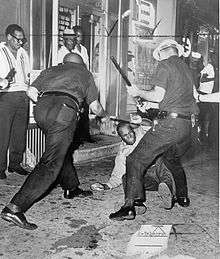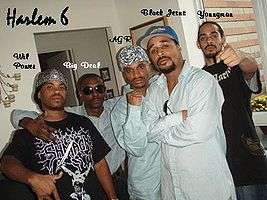Crime in Harlem

Harlem, a large neighborhood within the northern section of the New York City borough of Manhattan, is known as one of the worst areas for poverty and crime in New York City and the United States.[1] Crime in Harlem is mainly related to petty theft, murder, drugs and prostitution and violence. Violence, especially in East Harlem, has worsened since the 1980s with crack cocaine and other drug addictions. As of 1995, the leading cause of death among black males in Harlem was homicide.[2] According to a survey published in 2013 by Union Settlement Association, residents of East Harlem perceive crime as their biggest single concern; at the same time, the police department's statistics show an increase in crime by 17 percent over the previous year.[3]
Crime in Harlem is mainly related to petty theft, murder, drugs and prostitution.
Background

Harlem was seen as sophisticated in the later part of the nineteenth century. Over the years, however, organized crime by gangsters of Italian, Jewish, and Irish origin, such as colorful personalities as Lucky Luciano, began to rise in Harlem. This gradually built its notorious reputation.[4]
Since the 1920s, Harlem has been known as a major African-American residential, cultural and business center. Black residents began to arrive en masse in 1905, with numbers fed by the Great Migration.[5][6] In the 1920s and 1930s, Central and West Harlem were the focus of the "Harlem Renaissance", an outpouring of artistic work without precedent in the American black community and it even came to be known as "the capital of black America." However, with job losses in the time of the Great Depression and the deindustrialization of New York City after World War II, rates of crime and poverty increased significantly.[6]
In the Italian sector of the Harlem an organization titled “the Black hand" had emerged between 1901 and 1921 in the Second Avenue which indulged in blackmail. There were unsuccessful attempts by the Italian residents of Harlem in the 1930s to improve their housing situation but they failed resulting in their migration out of Harlem; highly unhealthy slums contributed to this.[7] The Italian community living in Harlem who were seen in the streets as much as in their houses even established a "boys club" (started in 1927) in their midst to divert attention and to wean away the boys from the influence of the gangs. The Italian part of the Harlem constituted immigrants of 64 regional societies in 1934 and many of them observed festivals in the church of mount Carmel. They were also segregated from the Spanish part of the Harlem.[7]
In 1931, Dutch Schultz, a mobster, exercised control over the wealth of Harlem residents with perpetration of violence and blackmail involving banks, restaurants, and clubs taking advantage of his political and police contacts. After he was killed in 1935, the mantle of control fell on the Genevese family, who ruled the roost for the next 50 years.[8]
During the Second World War period, newspapers such as the New York Times sensationalized the crime situation and claimed that it was going up. However, the ground situation did not reflect this view, because in 1942, there was a reduction in crime rate.[9]

Like in Chicago, New York City during the Depression and post World War II saw a dramatic increase in organized criminal rackets and the gangsters of Harlem have been among the most notorious in American history. Gangsters such as Frank Lucas, hailed as the "baddest dude on the mean streets of Harlem", operated a gang which smuggled heroin into the states from Vietnam in US warplanes in the late 1960s and early 1970s.[10] Major riots broke out in Harlem in 1964, violently suppressed by the police.[11]
Cheap crack cocaine in East Harlem, which became a major issue in the 1980s, as author Russell Leigh Sharman puts it was "largely responsible for the devaluation of human life in East Harlem: it radically affected the economy of violence in relation to the illegal drug trade."[12] East Harlem has the highest violent crime rate in Manhattan.
Since New York City's revival in the late 20th century, Harlem has been experiencing social and economic gentrification. However, Harlem still suffers from many social problems. Large portions of the population receive a form of income support from the government, with 34.9%, 43.3%, and 46.5% of the populations of West, Central, and East Harlem receiving aid.[13]
Organized crime
There are many gangs in Harlem, often based in housing projects, such as the True Money Gang (Johnson Houses); Air It Out (Taft Houses); and Whoadey (Lehman Houses). When one gang member is killed by another gang, revenge violence erupts which can last for years.[14] The East Harlem Purple Gang of the 1970s, which operated in East Harlem and surroundings, was an Italian American group of hitmen and heroin dealers.[15]
Services
There are six subcommittees which deal with the key issues in Harlem. These are: "crime and police, health and hospitals, housing and recreation, education, discrimination in employment, and discrimination in relief."[16] The New York City Police Department patrols five precincts located within Harlem. The areas of West Harlem are served by the 30th Precinct,[17] the areas of Central Harlem are served by the 28th[18] and 32nd Precincts,[19] and the areas of East Harlem are served by the 23rd[20] and 25th Precincts.[21]
The Harlem Community Justice Center identifies problems and seeks solutions for a variety of crimes and disputes in East and Central Harlem. The multi-jurisdictional civil and family court offers programs in conflict resolution, financial support, at-risk youth, and re-entry for ex-offenders. Its goal is to work together with a community in order to facilitate neighborhood renewal.[22]
Y.U.N.G Harlem is a non-profit organization which advocates for the area's youth while also providing leadership resources. The organization's leaders were honored at Black Entertainment Television’s 3rd annual “Black Girls Rock” awards.[23]
In music
Like the Bronx, Harlem and its gangsters have a strong link to hip hop, rap and R&B culture in the United States, and many successful rappers in the music industry came from gangs in Harlem.[24] Harlem 6 for instance, a group affiliated with the Wu-Tang Clan and Gang Starr Foundation, takes its name from a group of six young African American and Hispanic teenage men from the 1960s who were wrongly accused of heavy crimes that took place on 125th Street and Madison Avenue in Harlem, two of whom where murdered without evidence to support the charges. The media gave the group the name The Harlem Six, and the name is still used today in memory of the six young men.[25] Gangster rap, which has its origins in the late 1980s, often has lyrics that are "misogynistic or that glamorize violence", glamorizing guns, drugs and easy women in Harlem and New York City.[26][24]
References
- ↑ Finnegan, Jack (6 March 2007). Newcomer's Handbook For Moving to and Living in New York City: Including Manhattan, Brooklyn, the Bronx, Queens, Staten Island, and Northern New Jersey. First Books. p. 55. ISBN 978-0-912301-72-3. Retrieved 14 June 2013.
- ↑ Hagan, John; Peterson, Ruth D. (1995). Crime and Inequality. Stanford University Press. p. 37. ISBN 978-0-8047-2404-3. Retrieved 14 June 2013.
- ↑ Bellafante, Ginia (January 5, 2013). "Violent Crime Fell? Tell It to East Harlem". The New York Times. Retrieved 15 June 2013.
- ↑ "Gangsters of Harlem [Paperback]". Amazon.com. Retrieved 6 March 2015.
- ↑ "The Second Great Migration: A Historical Overview". Chicago: University of Chicago Press. 2009. Retrieved 17 June 2013.
- 1 2 "Harlem Renaissance". Biography.com. Retrieved 17 June 2013.
- 1 2 Robert A. Orsi (2002). The Madonna of 115th Street: Faith and Community in Italian Harlem, 1880-1950. Yale University Press. pp. 31–34. ISBN 978-0-300-09135-9.
- ↑ Cary D. Wintz; Paul Finkelman (1 January 2004). Encyclopedia of the Harlem Renaissance. Vol. 2: Index. Routledge. pp. 939–. ISBN 978-1-57958-458-0. Retrieved 17 June 2013.
- ↑ Nat Brandt (1996). Harlem at War: The Black Experience in Wwii. Syracuse University Press. pp. 168–. ISBN 978-0-8156-0324-5. Retrieved 17 June 2013.
- ↑ Chepesiuk, Ron (12 July 2007). American Gangster: The History of the Gangs of Harlem. Milo Books. ISBN 978-1-903854-66-2. Retrieved 14 June 2013.
- ↑ Jaynes, Gerald David (2005). Encyclopedia of African American society. Sage Publications. p. 402. ISBN 978-0-7619-2764-8. Retrieved 3 July 2013.
- ↑ Sharman, Russell Leigh (2006). The Tenants of East Harlem. University of California Press. p. 97. ISBN 978-0-520-24427-6. Retrieved 14 June 2013.
- ↑ "Community District Needs" (pdf). Official web site of New York Department of City Planning. 2012.
- ↑ Buettner, Russ (April 4, 2013). "63 Gang Members Indicted in East Harlem Shootings". The New York Times. Retrieved 15 June 2013.
- ↑ New York Magazine. 12, No. 19. New York Media, LLC. 7 May 1979. pp. 44–. ISSN 0028-7369.
- ↑ Naison, Mark (1 November 2004). Communists In Harlem During The Depression. University of Illinois Press. p. 145. ISBN 978-0-252-07271-0. Retrieved 14 June 2013.
- ↑ 30th Precinct, New York City Police Department, Retrieved 14 June 2013
- ↑ 28th Precinct, New York City Police Department, Retrieved 14 June 2013.
- ↑ 32nd Precinct New York City Police Department, Retrieved 14 June 2013.
- ↑ 23rd Precinct, New York City Police Department, Retrieved 14 June 2013.
- ↑ 25th Precinct, New York City Police Department, Retrieved 14 June 2013.
- ↑ "Harlem Community Justice Center". Center for Court Innovation.
- ↑ Hazelwood, Janell (June 14, 2013). "From Professionals to Philanthropists: Two Power Women Making a Difference in Urban Communities Y.U.N.G. Harlem founders talk civic leadership and power of giving back". Black Enterprise. Retrieved 15 June 2013.
- 1 2 Adjaye, Joseph K.; Andrews, Adrianne R. (1997). Language, Rhythm and Sound: Black Popular Cultures Into the Twenty-First Century. University of Pittsburgh Pre. p. 135. ISBN 978-0-8229-7177-1. Retrieved 14 June 2013.
- ↑ A Report from Occupied Territory JAMES BALDWIN (1924-1987) 11jul66 Retrieved 14 June 2013
- ↑ Ray, Michael (2013). Alternative, Country, Hip-Hop, Rap, and More: Music from the 1980s to Today. The Rosen Publishing Group. p. 78. ISBN 978-1-61530-910-8. Retrieved 14 June 2013.
| ||||||||||

